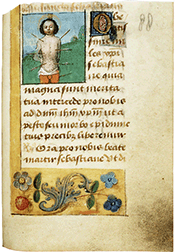
(Courtesy Kathryn Rudy, University of St. Andrews and National Library of the Netherlands)
In well-thumbed old books, certain
pages are more thumbed—and
therefore dirtier—than others.
What do those pages say about reading
habits? Using a device that measures the
optical density of a reflective surface,
Kathryn Rudy of the University of St.
Andrews in Scotland asked this question
of fifteenth-century personal devotional
prayer books—Books of Hours—
from the Netherlands. Hypothesizing
that grime in the lower corners of pages
would be roughly equivalent to time
spent reading the page, Rudy took readings
"from the juicy dirt at the bottom
of the page," she says.
The most popular passages in these
books tended to be prayers related
to indulgences (time off in purgatory
for forgiven sins) and health benefits,
such as protection from plague or St.
Anthony's fire. Self-interest was the
most common theme. In one manuscript
that had been enhanced with
custom illuminations, the owner primarily
looked at pictures—in particular
one that depicted the owner himself.
"He really loved that image," says Rudy.

